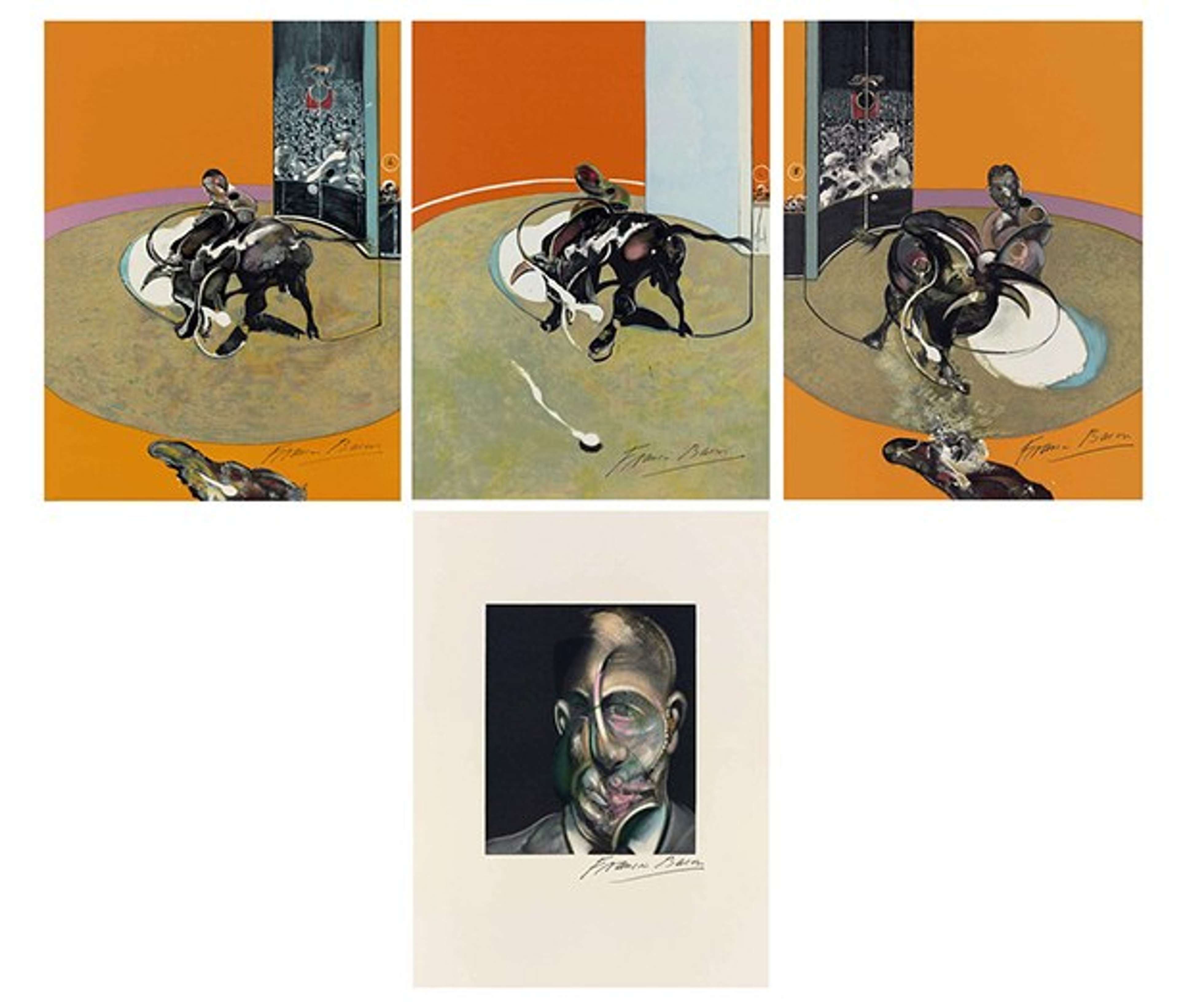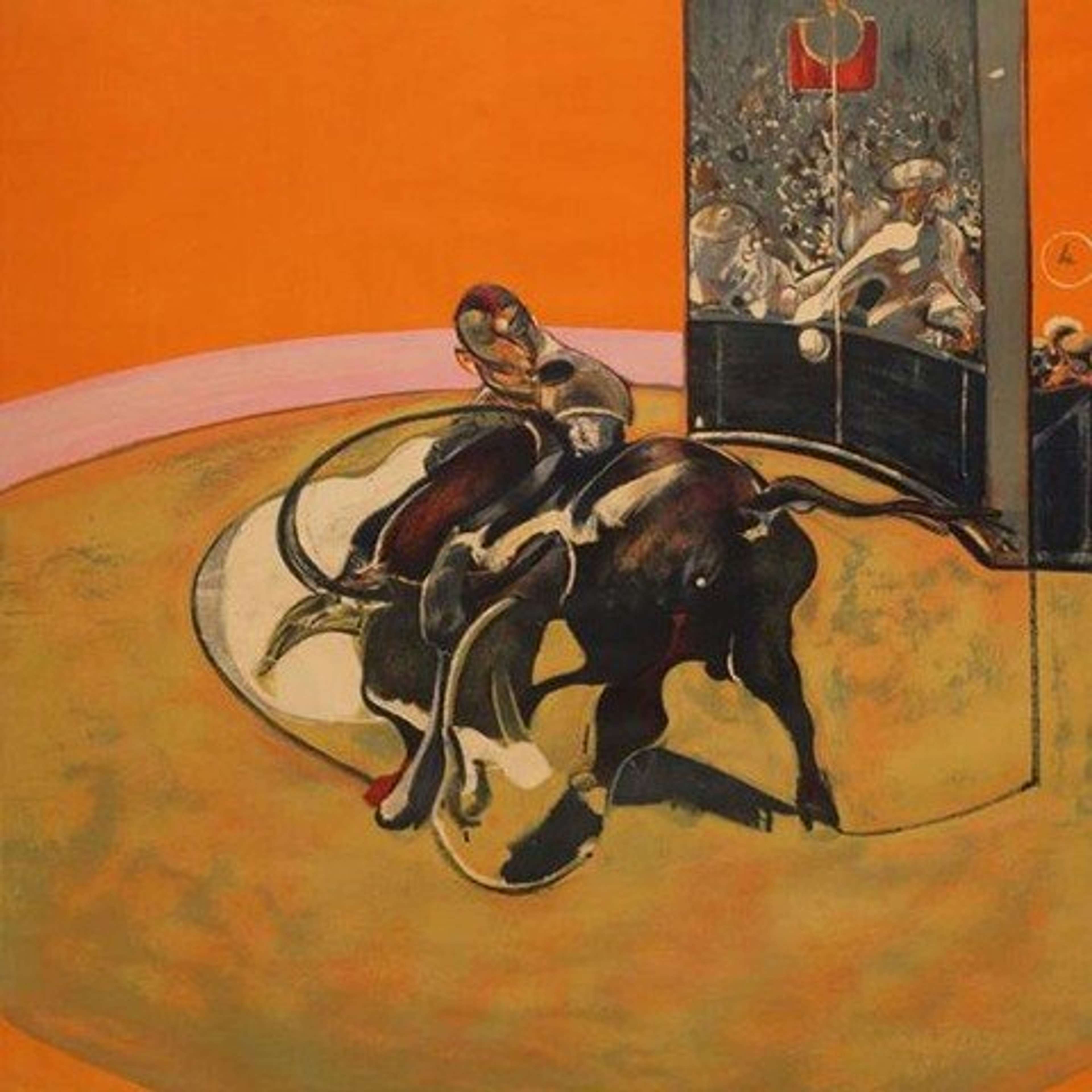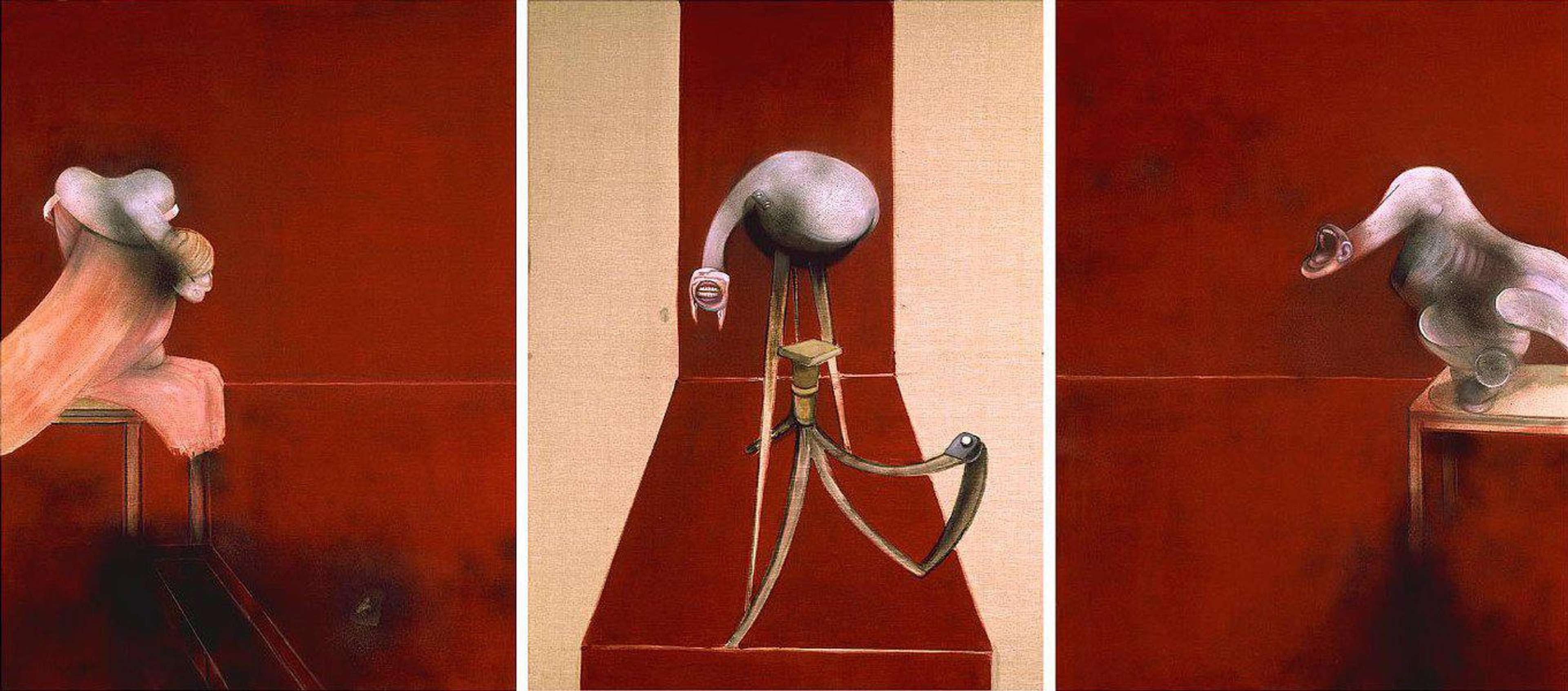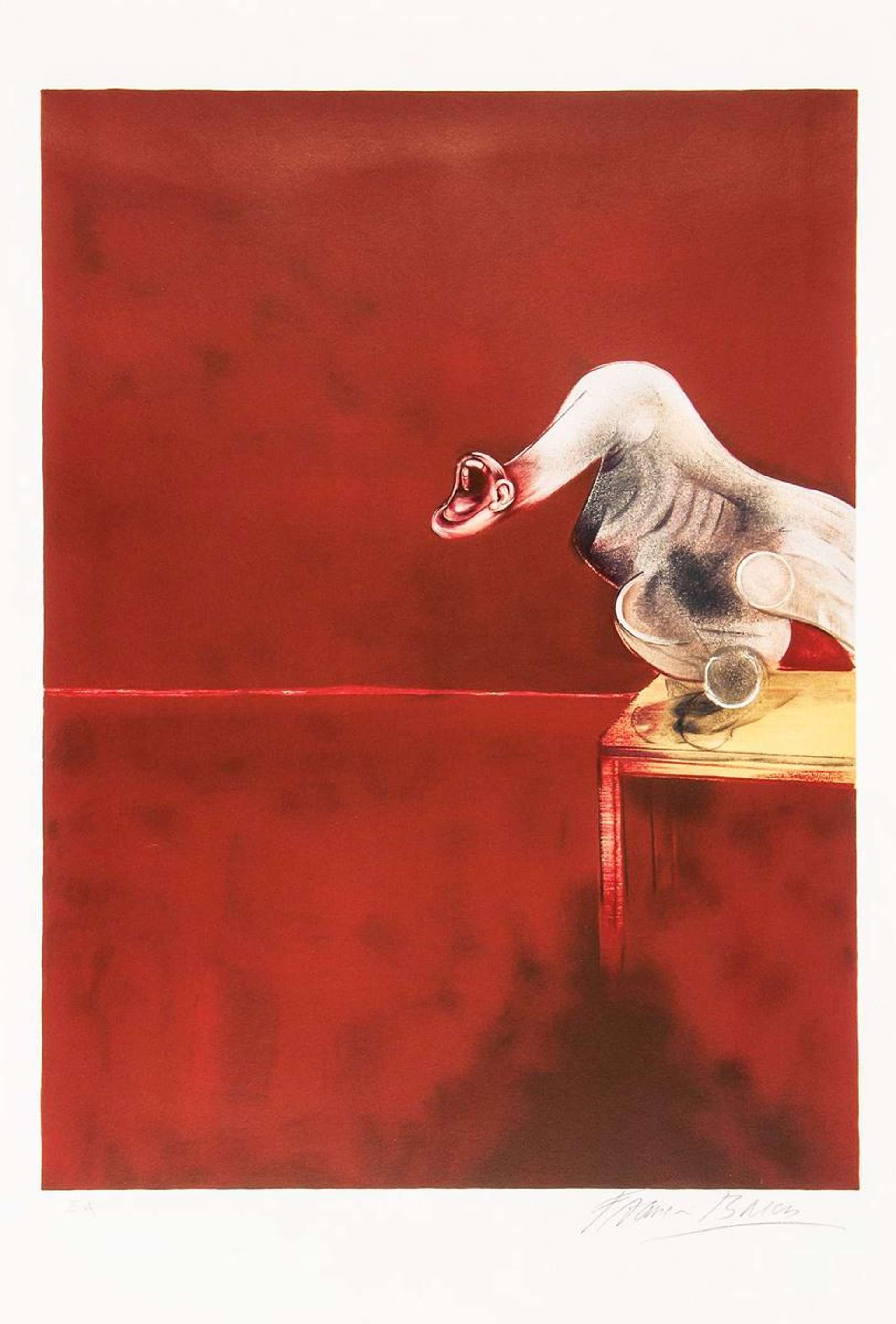 Triptych August (left panel) © Francis Bacon 1972
Triptych August (left panel) © Francis Bacon 1972
Francis Bacon
58 works
Key Takeaways
This buyer's guide to Francis Bacon prints provides essential insights for collectors, including how to identify key works, understand print editions, and evaluate provenance. It emphasises the importance of condition and market timing, offering expert advice for purchasing authentic Bacon prints. The guide highlights Bacon’s most sought-after works, explains the role of special edition prints, and analyses ways to maximise investment potential based of data-driven analysis. Whether buying for personal enjoyment or investment, this comprehensive guide helps navigate the intricacies of Bacon's print market.
Collecting Francis Bacon prints can be both rewarding and valuable, but it requires understanding the nuances of his market. This guide offers essential tips, from identifying key works and understanding editions to assessing condition and provenance. Whether you're a seasoned collector or a first-time buyer, this guide provides insights into what drives Bacon’s market, when to buy, and how to ensure authenticity.
Why Collect Francis Bacon?
Adding Bacon's artwork to your collection brings a distinctive allure, blending luxury with a deep psychological and art historical resonance. His work offers access to a raw, emotional intensity that few artists can match, challenging the viewer to confront complex human emotions and existential themes. Bacon’s art isn’t just about beauty or aesthetics; it’s about confronting the raw, often uncomfortable truths of human existence. His iconic depictions of distorted figures and expressions of existential dread push the boundaries of portraiture, inviting viewers into the turmoil of the human psyche. Each Bacon piece carries a weight of intensity that transcends time, making his works highly collectible for those drawn to complex and challenging themes, yet exude captivating imagery.
What types of Francis Bacon prints can you buy?
Starting a Bacon print collection requires understanding his entry into printmaking, which began in the 1960s as he explored various techniques to reinterpret his iconic paintings. For example, Three Studies for Figures at the Base of a Crucifixion (1944) is lauded as Bacon's earliest original masterpiece, with prints like After Second Version of the Triptych 1944 (1989), a replica of this work, emerging later. Bacon's Screaming Popes series, inspired by Diego Velázquez’s Portrait of Pope Innocent X (1650), also gained prominence. In the 1970s, Bacon expanded into lithography and etching, working with master printers like Georges Visat. Oediphus And The Sphinx (1984) is a work that demonstrates Freud's interest in mythology. His limited editions, including special proofs like hors de commerce (HC) and artist’s proofs (AP), are rare and highly sought-after by collectors. The scarcity of these prints significantly increases both their value and desirability in the market.
When starting a collection, it’s ideal to focus on Bacon's earlier prints from the 1960s and 1970s, which are known for their exceptional quality. Look for prints with verified provenance, especially those published by renowned galleries like Marlborough or Galerie Lelong. Always ensure that you're purchasing from reputable dealers or auction houses to guarantee authenticity, as Bacon's prints are rare and limited, making them highly valuable and rewarding investments for collectors.
Is Francis Bacon A Good Investment?
Bacon's market trajectory highlights the enduring appeal of his work, with his pieces regularly fetching millions at auction and often surpassing presale estimates. This demand is further bolstered by irrevocable bids (IBs) and auction house guarantees, reflecting collectors' confidence in the value of his art. A notable moment occurred in 2013 when Christie's dedicated an auction to his complete prints, showing a market index rise from 18.52 to 21.32–a 15% increase, indicating growing demand for his print works. Despite fluctuations, Bacon's limited print output and the intensity of each work make his prints highly desirable investments.
 Image © lluisribesmateu1969 / Miroir de la Tauromachie © Francis Bacon
Image © lluisribesmateu1969 / Miroir de la Tauromachie © Francis BaconHow Much Are Francis Bacon Prints Worth?
The value of Bacon prints can vary due to several factors. Many of his works were created as triptychs, and while individual prints may be sold separately, their value typically decreases compared to keeping the triptych intact, especially if the edition numbers match, which can command a premium. For example, Miroir de la Tauromachie, a portfolio of four lithographs, set a record at £106,250 at Sotheby’s in 2015. Special edition prints, such as those marked HC or AP, often sell at a higher premium.
Subject matter is also a key factor in the value of Bacon's work. His psychologically intense pieces, including self-portraits and portraits of his lover George Dyer and fellow artist Lucian Freud, consistently draw significant interest at public sales. However, whether collecting for personal enjoyment or investment, it’s essential to select a piece that resonates with you. Works by Bacon generally appreciate over time, with better returns typically seen over longer holding periods, making them both personally and financially rewarding.
 Study For A Bullfight No. 1 © Francis Bacon 1971
Study For A Bullfight No. 1 © Francis Bacon 1971What Are Some Popular Francis Bacon Prints Among Collectors?
In 2019 and 2022, Bacon's print market saw peak activity, with over 150 works sold publicly in each of those years. While the volume fluctuated slightly before and after these peaks, certain prints remained consistently popular among collectors. This suggests that despite market variations, there is steady demand for specific Bacon prints that continue to attract attention from buyers.
Deuxième version du triptyque: This work is a reimagining of Bacon’s iconic Three Studies for Figures at the Base of a Crucifixion (1944), created during a time when religious iconography was prominent in post-WWII art. This second version holds great value, achieving £73,860 in a Polish auction in June 2024, underscoring Bacon’s global influence.
Study for a Bullfight No. 1: Created in 1971, this popular print, produced in an edition of 150, has been frequently traded. Its latest sale in 2024 fetched £32,790, a significant rise from its 1999 auction price of just over £4,000.
Three Studies for a Self-Portrait: differs in that it presents three portraits on a single horizontal sheet rather than in the typical triptych format. This self-portrait, produced in an edition of 150, is based on original triptychs that have sold at auction, with the most notable being set against a black background, which achieved over £40 million in 2017. A variation in this print, an HC edition, sold for £38,664 in 2022. Given its significance in Bacon's oeuvre, this work remains highly valued in the market.
Authenticity: How do you know if a Francis Bacon print is real?
Bacon does not currently have an official authentication committee. While his works, including prints, were once authenticated, this process largely ceased after his death in 1992. Today, collectors rely on the Catalogue Raisonné published by The Estate of Francis Bacon as the definitive reference for his works.
Bacon was known for his perfectionism, closely overseeing the production of his editioned prints during his lifetime, collaborating with leading publishers like Marlborough Graphics and Galerie Lelong. Three posthumous prints, approved but not signed by Bacon, are stamped by his estate. Some prints are signed in felt-tip pen or pencil, while others may be unsigned but authenticated through provenance or blind stamps from his trusted printers, including Mourlot, Maeght, Polígrafa, and Atelier Arts Litho.
Before purchasing, it’s crucial to verify provenance and the print’s production history. Provenance can confirm authenticity and provide insight into the print’s value. Consulting with experts, is always recommended. At MyArtBroker, we are a team of experts specialising in the print market, with a deep understanding of the production and authentication of Bacon prints. Contact us for expert guidance and essential advice on verifying Bacon’s prints and navigating the art market. Our specialists are here to assist you with ensuring authenticity and making informed purchasing decisions.
Looking To Acquire Francis Bacon Prints?
Browse Bacon on the Trading Floor and sign up to MyPortfolio Collection Management.
How do you check the condition of a Francis Bacon print?
When purchasing a Bacon print, the quality of the print should be impeccable, as Bacon was known for overseeing the production process with meticulous care and sometime adding hand-finishing. Any condition issues are likely due to wear or improper preservation rather than flaws in printing. To ensure the print’s integrity, request to view it unframed, allowing you to inspect both the front and back for potential damage. Many of Bacon’s prints were produced on high-quality Arches wove paper, which typically retains its colour and texture well over the years. However, it’s crucial to examine the paper for any signs of aging, like yellowing, creases, or cracking, which may have affected the print’s condition.
Additionally, Bacon’s signature can be prone to fading, particularly if exposed to light over time. Therefore, it's important to verify that the signature is well-preserved, as this significantly impacts the print’s value. Before purchasing, it is always advisable to consult with an expert who can help identify any potential flaws.
For further guidance on restoring and caring for Bacon’s prints, MyArtBroker offers resources. The Directory connects you to external specialists in condition reports, framing, authentication, and more to ensure that your print purchase is fully informed and secure.
When should I buy a Francis Bacon print?
The best time to purchase Bacon prints is often before major exhibitions or retrospectives, which can significantly boost demand and prices. Recent examples include the 2019 Gagosian: Francis Bacon: Couplings in London and the prestigious Francis Bacon: Man and Beast at the Royal Academy of Arts in 2022. After these events, Triptych 1986-7 sold for £38.4 million, and Study of Red Pope 1962, 2nd Version 1971 sold for £37 million. To successfully navigate the Bacon print market and identify optimal buying opportunities, it's crucial to work with a professional who understands market demand and timing. At MyArtBroker, we offer expert guidance on Bacon print values and can help you make informed decisions. Get in touch to speak to one of our specialists and explore our live Trading Floor to discover real-time market demand and opportunities.
Where should I buy a Francis Bacon print?
Whether you're an experienced collector or buying your first print, it's crucial to purchase from a reputable seller. While online marketplaces like eBay may offer lower fees, authenticity and condition issues can arise with unregulated buying and selling platforms. Trusted sources, such as auction houses, galleries, or reliable online brokers like MyArtBroker, provide expert guidance on value, condition, and provenance. While auction houses are experts in the art trade, they can charge up to 25% in in buyers fees, plus other storage and shipping costs. At MyArtBroker, we offer expert advice, full transparency, and a seamless online buying experience. Explore our Auction versus Private Sale Guide to learn about the benefits and considerations of each selling method.
Why Use MyArtBroker To Buy Your First Francis Bacon?
A Dedicated Specialist
At MyArtBroker, we offer a secure, streamlined approach to acquiring Bacon prints. Our specialists gave extensive knowledge about Bacon’s print market and can provide expert guidance by connecting buyers to a reliable network of collectors and dealers. Whether you're a seasoned collector or making your first purchase, our team ensures authenticity through comprehensive condition checks, provenance verification, and artwork authentication. From purchasing to delivery, we handle every aspect with expertise and efficiency.
Our Network
With over 30,000 collectors and galleries actively engaged in the Bacon market, our extensive global network grants access to rare and valuable works. We frequently update our platform with market insights, auction results, and expert commentary on Bacon’s art. Explore our Trading Floor for available Bacon works or use MyPortfolio Collection Management to stay informed. For additional services such as art shipping, conservation, or framing, refer to The Directory for trusted professionals who can assist with every stage of your collection.











